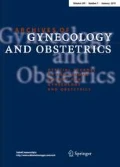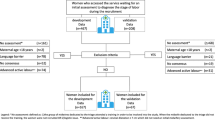Abstract
Purpose
To introduce LEIOA, a new screening method to forecast which patients admitted to the hospital because of suspected threatened premature delivery will give birth in < 7 days, so that it can be used to assist in the prognosis and treatment jointly with other clinical tools.
Methods
From 2010 to 2013, 286 tocographies from women with gestational ages comprehended between 24 and 37 weeks were collected and studied. Then, we developed a new predictive model based on uterine contractions which combine the Generalized Hurst Exponent and the Approximate Entropy by logistic regression (LEIOA model). We compared it with a model using exclusively obstetric variables, and afterwards, we joined both to evaluate the gain. Finally, a cross validation was performed.
Results
The combination of LEIOA with the medical model resulted in an increase (in average) of predictive values of 12% with respect to the medical model alone, giving a sensitivity of 0.937, a specificity of 0.747, a positive predictive value of 0.907 and a negative predictive value of 0.819. Besides, adding LEIOA reduced the percentage of incorrectly classified cases by the medical model by almost 50%.
Conclusions
Due to the significant increase in predictive parameters and the reduction of incorrectly classified cases when LEIOA was combined with the medical variables, we conclude that it could be a very useful tool to improve the estimation of the immediacy of preterm delivery.



Similar content being viewed by others
References
Behrman R, Butler A (2007) Preterm birth. National Academies Press, Washington, D.C.
Berghella V, Saccone G (2016) Fetal fibronectin testing for prevention of preterm birth in singleton pregnancies with threatened preterm labor: a systematic review and metaanalysis of randomized controlled trials. Am J Obstet Gynecol 215:431–438
Sahasrabudhe N, Igel C, Echevarria GC, Dar P, Wolfe D, Bernstein PS et al (2017) Universal cervical length screening and antenatal aorticosteroid timing. Obstet Gynecol 129:1104–1108
Newman RB, Goldenberg RL, Iams JD, Meis PJ, Mercer BM, Moawad AH et al (2008) Preterm prediction study: comparison of the cervical score and Bishop score for prediction of spontaneous preterm delivery. Obstet Gynecol 112:508–515
Lee SM, Park KH, Jung EY, Jang JA, Yoo HN (2017) Frequency and clinical significance of short cervix in patients with preterm premature rupture of membranes. PLoS ONE 12:e0174657
Paul MJ, Smeltzer JS (1991) Relationship of measured external tocodynamometry with measured internal uterine activity. Am J Perinat 8:417–420
Goodwin TM, Paul R, Silver H, Spellacy W, Parsons M, Chez R et al (1994) The effect of the oxytocin antagonist atosiban on preterm uterine activity in the human. Am J Obstet Gynecol 170:474–478
Millar LK, DeBuque L, Wing DA (2003) Uterine contraction frequency during treatment of pyelonephritis in pregnancy and subsequent risk of preterm birth. J Perinat Med 31:41–46
Hess WL, Mccaul JF, Perry KG, Howard PR, Morrison JC (1990) Correlation of uterine activity using the term guard monitor versus standard external tocodynamometry compared with the intrauterine pressure catheter. Obstet Gynecol 76:52–55
Berghella V, Iams J, Newman R, MacPherson C, Goldenberg R, Mueller-Heubach E et al (2004) Frequency of uterine contractions in asymptomatic pregnant women with or without a short cervix on transvaginal ultrasound scan. Am J Obstet Gynecol 191:1253–1256
Iams J (2003) What have we learned about uterine contractions and preterm birth? The HUAM prediction study. Semin Perinatol 27:204–211
Newman R (2005) Uterine contraction assessment. Obstet Gyn Clin N Am 32:341–367
Acharya UR, Sudarshan VK, Rong SQ, Tan Z, Lim CM, Koh JE, Nayak S, Bhandary SV (2017) Automated detection of premature delivery using empirical mode and wavelet packet decomposition techniques with uterine electromyogram signals. Comput Biol Med 18(85):33–42
Malaina I, Martinez L, Matorras R, Bringas C, Aranburu L, Fernández-Llebrez L et al (2017) Estimation of preterm labor immediacy by nonlinear methods. PLoS ONE 12:e0178257
Malaina I, Matorras R, Martínez L, Fernandez-Llebrez L, Bringas C, Aranburu L et al (2016) Montevideo units vs autoregressive models on preterm labor detection. In: International work-conference on time series. ITISE proceedings 2016. http://itise.ugr.es/proceedings2016/Proceedings_ITISE2016.pdf. Accessed 27 June 2017
Pincus S, Gladstone I, Ehrenkranz R (1991) A regularity statistic for medical data analysis. J Clin Monitor 7:335–345
Hurst H (1951) Long term storage capacity of reservoirs. Trans Am Soc Civil Eng 6:770–799
Fleisher LA, Pincus SM, Rosenbaum SH (1993) Approximate entropy of heart rate as a correlate of postoperative ventricular dysfunction. Anesthesiology 78:683–692
Lake DE, Richman JS, Griffin MP, Moorman JR (2002) Sample entropy analysis of neonatal heart rate variability. Am J Physiol Regul I 283:789–797
Jian-Jun Z, Xin-Bao N, Xiao-Dong Y, Feng-Zhen H, Cheng-Yu H (2008) Decrease in Hurst exponent of human gait with aging and neurodegenerative diseases. Chin Phys B 17:852–856
Maxim V, Şendur L, Fadili J et al (2005) Fractional Gaussian noise, functional MRI and Alzheimer’s disease. Neuroimage 25:141–158
Dawes G, Moulden M, Sheil O, Redman C (1992) Approximate entropy, a statistic of regularity, applied to fetal heart rate data before and during labor. Obstet Gynecol 80:763–768
Esposti F, Signorini M, Ferrario M, Magenes G (2006) Self-similarity behavior characterization of fetal heart rate signal in healthy and intrauterine grow retardated fetuses. In: 28th annual international conference of the IEEE Engineering in Medicine and Biology Society IEEE EMBS’06, pp 6157–6160
American College of Obstetricians and Gynecologists (2017) Methods for estimating the due date. Committee opinion no. 700. Obstet Gynecol 129:e150–e154
Barabasi A, Vicsek T (1991) Multifractality of self-affine fractals. Phys Rev A 44:2730–2733
Cao L (1997) Practical method for determining the minimum embedding dimension of a scalar time series. Physica D 110:43–50
Verhulst PF (1838) Notice sur la loi que la population suit dans son accroissement. Corresp Math Phys 10:113–121
Lusted LB (1971) Decision-making studies in patient management. N Eng J Med 284:416–424
Acknowledgements
This work was supported by the Basque Government (Grants PRE-2015-1-194 and IT974-16) and the Ferring S.A. Laboratories (Grant BC/A/16/004). Authors would also like to thank the Archive Service of Cruces University Hospital for their continuous help and effort on the sample acquisition.
Author information
Authors and Affiliations
Contributions
IM: protocol/project development, data collection or management, data analysis, and manuscript writing/editing. LA: protocol/project development, data collection or management, data analysis, and manuscript writing/editing. LM: protocol/project development, data analysis, and manuscript writing/editing. LF-L: protocol/project development, data collection, or management. CB: data analysis and manuscript writing/editing. IMdlF: protocol/project development and manuscript writing/editing. MBP: data collection or management and data analysis. LG: data collection or management. IA: data collection or management. RM: protocol/project development, data collection or management, data analysis, and manuscript writing/editing.
Corresponding author
Ethics declarations
Conflict of interest
Authors report that they have no conflicts of interest.
Electronic supplementary material
Below is the link to the electronic supplementary material.
Rights and permissions
About this article
Cite this article
Malaina, I., Aranburu, L., Martínez, L. et al. Labor estimation by informational objective assessment (LEIOA) for preterm delivery prediction. Arch Gynecol Obstet 297, 1213–1220 (2018). https://doi.org/10.1007/s00404-018-4729-1
Received:
Accepted:
Published:
Issue Date:
DOI: https://doi.org/10.1007/s00404-018-4729-1




